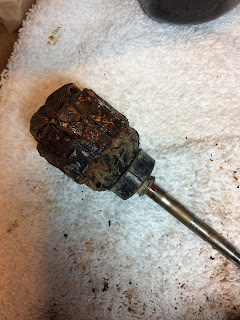In hindsight, I probably should have suspected that there would be problems. The Singer 201 I photographed a couple weeks ago did show some rust, had a frozen hand wheel, needed new wiring, and was missing a foot control and plug, but I still thought she could be cleaned up and doctored a bit and would be sewing again soon. I had high hopes.
My first clue should have been the rust on the potted motor casing. I knew I was going to have to clean the motor, but I was ready to take that on. As I began to take apart the machine I used The Vintage Singer Sewing Machines Blog's series on How to Rewire a Potted Motor as a reference. This is an amazing collection of pictures, videos, explanations and sequential postings that completely documents the process. Rain has produced a top-notch series here and his responses to questions posted by readers demonstrate such clarity and depth of understanding. Thank you, Rain, for such a thorough resource.
 |
| Rust on the motor casing: should have been a clue |
I started by accessing the motor leads in the terminal body. This machine did not have a plug, so I did not have to worry about unplugging the power source first. Some of the wire coverings were dry and cracked and they need to be replaced, but there was no sign of moisture and it was easy to disconnect the motor leads.
 |
| Everything looked dry--nothing beyond repair, yet |
Next, I removed the handwheel so I could access the motor housing.
 |
| The handwheel came off easily, but was clearly going to need a good cleaning |
 |
| The motor housing after handwheel was removed |
The motor housing needs a good cleaning to get out the old grease, but this still seems a doable task. I should have probably paid a bit more attention the the rust on the motor at the side of this pic. After cleaning out the housing, I removed it and the motor.
 |
| Motor housing has been removed |
 |
| Bobbin-winder comes with the housing |
Next, I removed the grease wicks, retaining clips, and springs. The clips and springs were set to soak in alcohol.
Moving on, I tried to take out the motor brushes, but only the spring came out without the brush attached. There was some buildup under the motor caps. Things started to take a significant turn for the worse when I tried to unscrew the motor cover. Those screws were rusted solid and had no intention of coming loose. I mean, really, just getting those screws loose probably took me 20 minutes. When I finally went to pry the cover off it also appeared rusted in place. Rain has a great photo on his blog about what I was should have (was hoping) to see when I took off the cover. You can see the picture
here. This is what I found instead.
 |
| Game over |
That's a lot of rust and crud. I don't think she can be resurrected. Going to have to let this one go. Just because I could though, I decided to keep dismantling the motor while I had it there. I took out the worm and that seemed be in very good shape. Then I took out the armature and that was in a sorry state. I mean, can you even tell where the metal plates are that you are supposed to be able to use to hold the armature? Now I've got a parts graveyard on my table. If anyone needs retaining clips, springs, grease caps, etc. let me know.
 |
| Armature caked in crud |
 |
| Inside of the motor minus the armature |
Ok, so this motor is not salvageable but I can still get the machine working, right? What is my next step? I know it needs new wiring and I have to get the handwheel unfrozen, but what options for power do I have? Can I get a new motor or should I think about converting the machine to a treadle? I have never sewn on a Singer 201 and liked the idea of having a motor, but I don't know if that's possible at this point. Any suggestions?









No comments:
Post a Comment